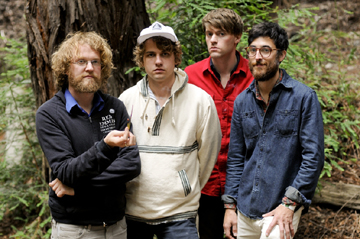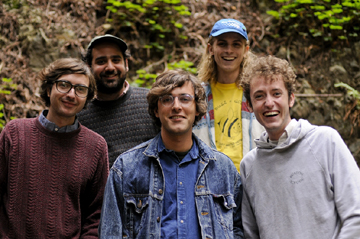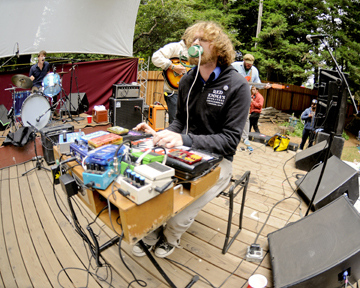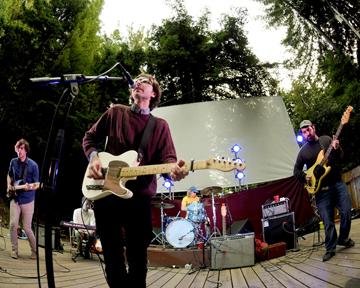Woods and Real Estate : A Scene of Their Own

Woods
Purchase College is located 33 miles north of Brooklyn, N.Y.‘s D.I.Y. capital, the Bushwick neighborhood, across the road from PepsiCo’s corporate headquarters in affluent Westchester County. Part of New York’s state university system – and known for its art department and purple-haired students – it’s an oasis nestled among the cookie-cutter suburbs – secluded enough to spur creative thought but close enough to New York City for students to be able to try those thoughts out on a live audience.
For many years, actors, dancers and brainy types topped the college’s notable alumni list, but during the past decade or so, Purchase has nurtured the musically inclined ranging from songstress Regina Spektor to electronica-freak Dan Deacon to alt-country troubadour Langhorne Slim.
It’s also the place where Woods singer/guitarist/visionary Jeremy Earl first met tape-effects technician G. Lucas Crane, guitarist Christian DeRoeck and multi-instrumentalist Jarvis Taveniere around the turn of the millennium.
“These art schools are springboards for people who didn’t grow up in a city and don’t have access to that world right off the bat,” shrugs Taveniere, a surprisingly clean-cut 33 year old who grew up a few towns away from Purchase. “I’d never have thought to move to Manhattan from my little town.”
On this rainy April afternoon, the members of Woods have returned to Purchase to play Culture Shock, a weekend of underground, experimental and often psychedelic music that one of the weekend’s performers describes as the “best bill of the year” in a tweet.
The crowd is decidedly punk but the experience feels almost like an acid test designed to repossess the state-owned school property: the space is filled with angularly positioned couches, mind-warping visual art and the drone of thrashing noise jams. Taveniere’s shirt, which mashes elements of the Grateful Dead’s and the Misfits’ logos, seems to sum up the general ethos of a scene filled with musicians who cut their teeth on classic punk and golden age jambands before settling into Brooklyn’s neu-psychedelic underground.
Given Purchase’s proximity to Brooklyn, the members of Woods and fellow performers Real Estate carpooled to the show – something that they are quite used to doing after three years of joint tours, shared recording sessions and other fraternal collaborations.
The entire experience feels pretty rock and roll – except that Culture Shock can’t legally sell alcohol. But it’s not a problem for the Woods crew who lead a quick expedition to the school’s cafeteria for a few beers before show time.
“I didn’t realize how well we got along with Woods until we toured with other bands,” says Martin Courtney, Real Estate’s slim, thoughtful and slightly elusive primary songwriter. “It felt so comfortable with them – they’re just our friends, we can hang out.”
Within a few months, both Woods and Real Estate will headline New York’s Bowery Ballroom and San Francisco’s The Independent – signifying their entrance into the national mainstream indie pipeline – thanks to their new albums, Sun and Shade and Days, respectively.
In certain ways, they are studies in contrast: Sun and Shade is sonically warm and lyrically twisted; Days is melodically somber but grows fuzzier through its nostalgic tales. But they are both vanguard statements from a bourgeoning psych-pop scene that somehow connects the dots between the Grateful Dead’s Live/Dead and classic Stooges before bouncing off of Phish and Animal Collective.

Real Estate
Real Estate’s Courtney (guitar/vocals), Alex Bleeker (bass) and Matthew Mondanile (lead guitar) grew up in the shadow of New York City, in the comfortable confines of Ridgewood, N.J. Like most teenagers, their early jam sessions took place in basements and at school-sponsored talent shows, though, occasionally, someone’s parents would let them throw a backyard party.
“Our friendship was very much based on music – we’re definitely responsible for each other’s tastes and styles,” says Bleeker, a burly, bearded, onetime theater student who gives off an affable ‘dude vibe.’ It’s June and he’s nursing a draft beer near the New Paltz, N.Y. studio where Real Estate is finishing Days. “Matt taught me how to play guitar as much as anybody else.”
Throughout high school, the three musicians followed each other’s tastes as they drifted between various alternative, punk and ska fads. One project focused on Strokes covers while another found Bleeker and Courtney playing Weezer’s “Blue Album” front-to-back. They also have roots in the jamband scene.
“We were all into it, but I really pushed the jamband stuff – we covered [Phish’s] ‘First Tube’ and jammed out ‘Dirt,’” says Bleeker as he rattles off his stats for bands like Phish, the Disco Biscuits, the Flecktones and various Grateful Dead spinoffs. “When I found Nugs.net, I felt like I had found this secret corner of the Internet.”
In certain ways, Northern New Jersey in the late ‘90s and early aughts was a blueprint for Brooklyn’s current D.I.Y. scene. The country’s most densely populated state – and a stone’s throw from New York – Jersey provided a natural network of all-ages shows that took shape at American Legion lodges and liberal suburban homes. School music programs taught kids how to play and the Garden State’s curious reputation gave aspiring rockers something of a unified, outsider edge.
“We played in [Veterans of Foreign War] VFW halls and churches, but at the same time, we were also going to shows every weekend in the best city in the world,” reasons Mondanile, the band’s most technically proficient musician and most avid record collector.
Courtney, Bleeker and Mondanile separated temporarily during college but got an early taste of life on the road when they recorded and toured as the backing band for another childhood friend, psych rock guitarist Julian Lynch.
Though Courtney eventually left the Lynch gig, fans got an early peek at Real Estate’s future lineup when Mondanile brought in Etienne Pierre Duguay, a drummer from his collegiate hometown, with whom he had collaborated in a band called Predator Vision. “I hid a recorder in the rafters, we took acid and started playing,” Mondanile says of his side project’s creative process with Duguay. “We were excited about the possibility of coming up on acid while jamming. Afterward, when we were coming down, we listened to the cassette while watching [the movie] Predator.”
After college, Courtney, Mondanile and Bleeker drifted toward home without much of a plan. Bleeker defected to Philadelphia, Courtney worked at a New Jersey greeting card company and Duguay became something of a man about Brooklyn. Mondanile, for his part, continued recording experimental, loop-heavy sounds in his parents’ basement under the moniker Ducktails.
While sharing some vodka by Courtney’s family pool in the summer of 2008, the four friends started toying around with a batch of songs the singer had quietly been working on.
“I was living at my parents’ house and experiencing all the weird shit that goes along with being in the suburbs again,” says Courtney. “That formed the aesthetic of the band for a while but we never had a specific style or genre. We incorporated all this music we loved.”
Those sounds included spacey loops, psychedelic flourishes, jamband grooves, ‘70s Yacht Rock cheese, melodic surf pop and an overall, reverb-drenched, chill vibe. “We wanted it to sound old, timeless,” Courtney continues. “I like invoking a mood and hoping people can put their own meaning on it. These [stories] are personal to me but I like to keep them vague.”
“When we started the band, Etienne and I would say, ‘How can we secretly make Real Estate a jamband?’ Bleeker says bashfully. “Without Matt or me, Martin’s songs would sound like The Shins.”
Figuring that they could all work at the Courtneys’ family real estate agency if the music thing didn’t work out, they decided to name Real Estate. “It was right when the recession hit – when the whole housing thing fell apart,” Bleeker recalls. “Even kids in finance weren’t getting jobs. It seemed justified that we were going play music while everything blew over.”
Inspired by successful Jersey garage bands such as Vivian Girls and Titus Andronicus, Real Estate started gigging and – thanks to a network of all-ages venues chaperoned by independent promoters like [New York-based] Todd P – solidified as a band in front of a live audience.
“It was tangible,” says Bleeker. “[Those bands] were able to blaze a trail for us and there was a sense of friendly competition.”

Woods live
Meanwhile, on the other side of Manhattan, Woods was taking shape in Brooklyn. Though DeRoeck, Earl and Taveniere were friends in college, Woods didn’t begin until around 2004 and didn’t really get off the ground until a few years later.
“Music was just something to do for fun in college, but when we moved to Brooklyn, things changed,” Earl says dismissively of his Purchase years when he studied fine art and printmaking. Ironically, his visual art background is what makes Woods more than a band: everything from his thick-rimmed glasses to his band’s hand-drawn album art to his careful statements feels tied to some greater artistic vision.
“It’s the poor man’s art school,” DeRoeck says bluntly of Purchase. “All these kids take drugs and make music in the woods. Most of it sucks but some of it ends up being pretty good.”
Earl, Taveniere and DeRoeck moved to Bushwick after college and set up shop at the Rear House, a freestanding house surrounded by brick buildings that served as their communal crash pad, recording studio, rehearsal space and headquarters.
“It was really cheap for the neighborhood – just a couple hundred bucks each,” Taveniere reminisces. “[It was] pretty close quarters but we made music all the time in the living room.”
All three musicians dabbled in a number of different projects, including mildly successful hardcore and indie outfits. They also reconnected with tape-effects maestro G. Lucas Crane, a literary buff living another life as an experimental audiophile.
“At Purchase, I knew Lucas as this weird dude,” Earl chuckles. “In Brooklyn, he lived at [artist collective-cum-venue] Fort Awesome and became involved in the underground, experimental music scene.” (Crane also wired the influential Queens, N.Y. club Silent Barn.)
Despite their perseverance, the band members’ previous projects never attracted national attention. “We were a band for five years and worked hard – we toured the U.S. three or four times and it didn’t really go anywhere,” admits Earl. “I started fiddling around on guitar, recording on a four-track. That was basically how Woods started: me in a bedroom learning how to write songs.”
Along with DeRoeck and Taveniere, Earl started recording creepy, freak-folk pop nuggets that had the ability to unwind into kraut-rock jams. Fueled by his hardcore past and previous failures, Earl’s falsetto fell somewhere between angelic and demonic sounds. The overall formula worked.
“Woods picked up,” Earl says simply. “Maybe some things were easier because we sort of knew what to do – we got presented with different, bigger opportunities so we just took it and ran with it.”
At a time when many bands shied away from the jamband tag – and still used MySpace to promote their music – Woods listed “jamband” as one of their styles on MySpace.
“We thought it was fun to push that from the beginning because we did jam, we were a band, " says Earl, who grew up listening to Phish and Medeski Martin and Wood alongside punk and is still an outspoken Dead fan. “We’re not your everyday jamband but we do come from a similar place [like] the Grateful Dead.”
Crane blossomed into an integral part of the band’s live show, adding keyboards and tape effects as well as singing through headphones that he had rewired as a microphone.
“He was always just our smart friend – he never played traditional instruments,” Taveniere says before pausing to rephrase. “I guess he still doesn’t play any traditional instruments.”
As Woods took shape, DeRoeck left the band. Though the exact reasons for his departure are unclear, various indicators point to a drug problem. (Now clean, he continues to perform under the name Little Gold.) In need of a roommate, the rest of Woods sublet space to Kevin Morby, a local musician barely out of his teens who ended up joining the band on bass. “He turned 21 on Woods tour,” Earl adds with a sense of familiar reverence.
Earl, a natural leader and source of intrigue for everyone interviewed for this feature, solidified his place as family patriarch by forming a record label, Woodsist, in 2006.
Woodsist went on to release early recordings by blogger buzz bands Kurt Vile, Wavves, Vivian Girls and numerous others. “I’d meet these bands in the middle of nowhere, and thought, ‘I’ve gotta put out a record for them,’” says Earl. “I started with tapes and that evolved to where I could actually press a record.”
His A & R role also led him to the Real Estate family.
Initially, Earl was interested in signing Mondanile’s Predator Vision project, but Mondanile pushed him to consider Real Estate instead. At first the members of Real Estate were unsure about the deal. “I’m self-conscious – I don’t know if anybody likes our music,” Courtney says naturally, shifting his eyes toward the ground. “I wondered if he just liked us because we were [featured on the website] Pitchfork.”
Given their shared stylistic roots, regular guy demeanors and ability to tour with jamband fervor while recording like indie audiophiles, the members of Woods and Real Estate quickly transitioned from labelmates to friends. A few key collaborative bills and numerous recording sessions helped blur the lines between individual bands to the point where often appear like members of a larger collective capable of breaking off into any number of teams.

Real Estate live
Real Estate’s self-titled album, released in late 2009, was a grassroots success story that reset Zach Braff’s Garden State experience in Yo La Tengo’s slightly darker Hoboken, N.J. neighborhood. The next 18 months were filled with a series of small, decisive victories, including a tour with indie rock band Deerhunter, increased exposure on influential blogs and coveted festival spots. In a matter of months, the band became so ingrained in the Brooklyn underground that Duguay even moved into the notorious Bushwick hipster artist loft and venue, Market Hotel, fulltime.
Before the band had a manager or record deal outside Woodsist, Phish had already used their song “Snow Days” as post-show music in Worchester, Mass. one snowy night in 2010. Woodsist also put out music by Ducktails – including a single that featured Animal Collective’s Panda Bear – as well as Julian Lynch. Woods continued to churn out music at a rapid pace too, releasing Songs of Shame (2009) and _At Echo Lake _(2010) to wider acclaim.
In 2009, Earl took an adult leap and moved away from his band and girlfriend, back to his blue collar, Upstate New York hometown of Warwick. “I love Brooklyn, but there are a lot of distractions,” admits Earl. “When you get in a sort of closed environment in the woods with not really much going on downtown, it’s nice to just lock yourself in and concentrate.”
In Warwick, he works investment banker’s hours, getting up early in the morning to focus on his label and creating music at night. Taveniere also moved out on his own, though he still uses Rear House as his studio (and as part of his Gmail address). “We’ve separated the home life and the recording studio life after living in a practice space for five years,” Earl explains.
After a few years of steady growth, 2011 proved to be a breakthrough year for both bands. Benefiting from indie rock’s newfound interest in psych, Woods played a marquee spot at Chicago’s Pitchfork Festival and helped curate the second annual Woodsist festival in Big Sur, Calif. They also released the fully realized roots-rock freak-out Sun and Shade, which Earl and Taveniere primarily recorded in Warwick during separate summer and snowstorm sessions.
The year started off blurry for Real Estate, who parted ways with Duguay, though he remains a friend and plans to work with Mondanile as Predator Vision next year. After Real Estate released their most mature statement to date, the Fleetwood Mac-inspired single “Out of Tune,” Courtney also finished a batch of songs for Days.
“It’s reflective and nostalgic but of an earlier period than the first record, when I was 17 or 18 years old driving around in the summers,” Courtney says. “It’s harder for me to reflect on my current life – I don’t want to get super personal.”
Even Bleeker, who has known Courtney for years, often observes his lyrics from a distance: “Martin’s not very candid about his lyrics. I didn’t even know what some of them were about until we were in the studio. He’s more shy and guarded, so the best way to get to know him is through his music. If anyone’s going to talk onstage, it’s going to be Matt and me. I asked Martin if that’s OK and he said, ‘I want you to because someone needs to.’”
The group initially used their own touring money to record Days with noted producer Kevin McMahon (Titus Andronicus, Swans, Ha Ha Tonka), but landed on Domino Records before the album’s completion. They also added touring keyboardist Jonah Maurer and new drummer Jackson Pollis to their lineup, though Courtney and Mondanile played most of the album’s drum parts. When asked if it was hard to leave Woodsist, Mondanile says, “The Woods family will always be there – those dudes are our buddies, but it is exciting to work with Domino.”
“Matt and I get into little fights, like we’re siblings,” Courtney says a few weeks before Days’ release. “Bleeker’s always good at seeing through the bullshit and being able to keep us focused. Sometimes, I’m acting as our manager and sometimes I’m lazy and forget to respond to emails and Bleeker has to kick my ass.”
“I think everyone’s role is pretty well defined at this point, which is not to say that we’re open to having that shift,” Bleeker says of the band’s dynamic. “I have a song on Days and that wasn’t going to happen before. Real Estate is Martin’s main project, but we are not ‘Martin and the other guys’ – he could get a better bassist than me but we’re a band – we bring that suburban friendship.”
Mondanile, a Seinfeld fanatic, sums up the band’s dynamic as the following: “Martin is Elaine, Bleeker is George, Jackson is Jerry’s Mom and I am Jerry Seinfeld/Kramer.”
*
Real Estate and Woods are now at the center of a mini-universe that not only includes other Woodsist label acts but also alter-ego bands like Ducktails and Bleeker’s Crazy Horse-inspired jam outfit The Freaks, which has included all of the members of Real Estate at various points. When Domino signed Real Estate, they agreed to take on their side projects as well.
As the Woodist label expands, Earl has also learned how to wear two hats. “Lately, it’s been tough doing both band and label – I’m at the point where I’m gonna hire someone to take care of some label stuff, especially while I’m touring. On this last tour, my girlfriend was nice enough to do the mail order for me.”
Though Woods may represent the new model of success in the digital, blogosphere-age – able to make it from basements to ballrooms without radio play, proper funding or even traditional managers – Earl still looks to a model that’s proven to work for artists like Phish where being in a band is as much about creating a community as it is putting out albums.
“In my head, I’m already thinking about next year,” Earl says skipping ahead to the Woodsist festival this coming summer. “Hopefully, we’re gonna do it a little bit bigger with camping included.” He pauses to smile. “We’re getting close to being like one of the big jam festivals.”



















